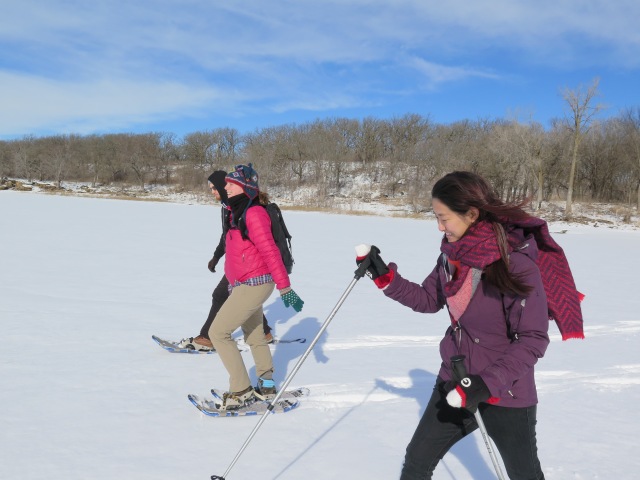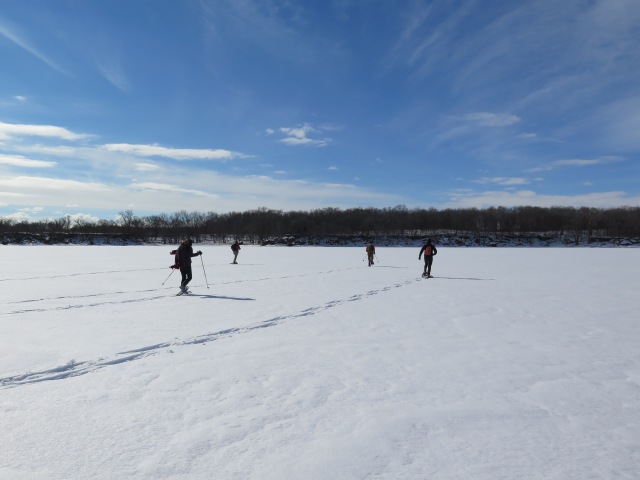Louisville Swamp: Backcountry Snowshoeing to Historic Jab’s Farm

Hello friends,
As I write, I am sitting in the sunroom of my apartment. I can hear the sparrows chirping outside, all huddled together due to the cool, crisp morning. I see a handful of brave birds leaving their shelter to scavenge for plant matter, which’ll be used for their nests. I even see a bunny that found the carrot greens I left out the previous night. This scene reassures me that Spring has come— 春が来た (haru ga kita). For most of us Twin Citizens, we all know that winter lingers longer than expected at times, but I think that this winter will be behind us before we even know it.
Well, before I get too carried away talking about Spring, let me tell you about a fun wintery activity I did with my sister and a few friends in February.

Jim looking out towards the Minnesota River Valley’s Louisville Swamp.
Louisville Swamp: Backcountry Snowshoeing to Historic Jab’s Farm
In my previous post, I mentioned that there were two highlights while my twin sister was visiting. The first was a cabin getaway with friends in Hayward, WI; the second was returning to one of my favorite parks in Minnesota—Louisville Swamp—during the winter and snowshoeing across the swampy valley to the historic Jab’s Farm.
We arrived at the entrance of Louisville Swamp—adjacent to the Renaissance Festival parking lot—in the early morning. The group consisted of my sister, her two friends Ted and Weige, and my friend Jim. Before setting off, I did a short snowshoe demonstration for everyone (similar to the demonstration I would give while on one of my L.L. Bean guided tours). After everyone was acquainted with their snowshoes, we began our snowshoe journey through the snow-clad prairie and oak savanna.

My sister with oak savanna as her backdrop.

Colleen’s friends Weige and Ted (and Colleen in the back). Ted visited from Pittsburgh and Weigi visited from Boston.
Though I had been to Louisville many times,—generally to look for wildflowers or birdwatch—I had never explored the park during the winter. It was a whole new experience seeing the frozen landscape, especially the frozen swamp itself. It was delightful. Oddly enough, while following the upper terrace trail (Mazomani Trail), we found ourselves in the middle of a flock of Eastern bluebirds. I wasn’t expecting to birdwatch while on our winter adventure, but the unexpected warm winter must’ve encouraged these migratory birds to fly north a bit earlier than usual. It was a treat to see vibrant blue brighten the stark, white scenery.
As we enjoyed the view from the upper terrace, Jim gave Weige, Ted, and Colleen a brief natural history of the Minnesota River Valley. I’ve read a lot about this river, but it’s always nice to relearn the geological and ecological history of this beautiful area. In summary, during the most recent glacial period, the Minnesota River used to be much wider. During this time, the river carved out a wide, sweeping valley from South Dakota all the way to Minneapolis/St. Paul; thus, the Minnesota River Valley. Now, the river is much smaller and a fertile valley surrounds the river, allowing diverse ecosystems and biomes to thrive. Louisville Swamp is a prime example because this corridor of the Minnesota Valley National Wildlife Refuge is one of the most diverse. It includes marsh, lakes, streams, oak savanna, restored prairie, rock formations, bottomland forest, and upland forest. And that’s only the different types of ecosystems. If I were to list off the number of fauna and flora that live within each of those ecosystems, this blog post would go on for a very long time. So, that’s why I love Louisville Swamp. I love the diverse landscapes and the unpredictability of bird sightings since there are so many birds that seek refuge in the area.

Beginning our hike across Louisville Swamp
After our history lesson, we descended into the valley and followed a trail until there was a clearing to the swamp through the lowland forest. When we reached the shore, Jim pointed to the island in the distance and said we should walk out to it and eat our lunch there. We all agreed and happily snowshoed across the frozen shore.

Jim at the edge of the island pointing to the best place to climb up
While walking towards the island, I looked straight ahead and was so surprised by how clear everything looked. The sky was a crystal blue, the clouds and snow were a pure white, and the island seemed almost like a painting, framed by the surrounding scenery. I stopped walking and I placed my hands in front of me and made a rectangle out of my fingers. I internally framed the island within my hands and imagined it as an actual painting. It was fun when Colleen and my friends eventually walked into the frame. It made natural painting all the better.

Colleen and Jim prepping lunch
We made it to the island, climbed to the top of a boulder, and ate our lunch. There was a wind that cut through our coats and gloves, but it didn’t really bother me too much since I was eating delicious food with such great company.

Walking toward the southwest side of Louisville Swamp
I haven’t mentioned about the backcountry aspect of this trip. Well, once we were off-trail, we had to make our own. As seen above, when we hiked to the island and then to the SW side of the swamp, we only had the sun and the untouched snow to guide us. Luckily, Louisville Swamp isn’t a complicated place, so we knew if we walked SW that we would find our final destination: Historic Jab’s Farm. Climbing up the terrace on the southwest side was not as easy as the north side. We eventually found an entry point and carefully walked up the terrace, using the snowshoeing knowledge I had taught earlier in the day.

Ted leading the way to Jab’s Farm
Once we reached the upper terrace, we found a trail surrounded in bluff-upland forest that lead us directly to Jab’s Farm. I had visited Louisville almost a dozen times, but I had never seen Jab’s Farm—mostly due to Flood’s Road Trail being flooded each time I had visited previously. So, I felt exhilarated when I finally saw the rooftops of the old farmsteads in the distance and even more so when we were able to snowshoe in-between the ruins. From within, you could see a barrel stove and the remnants of windows and floorboards (I believe some of the ruins were refurbished by the park system). I wonder what it must’ve been like to live in such an isolated place back in the late 19th century.
(I won’t go into detail, but this area hosted parts of the 1862 US-Dakota War. I wrote about it in my previous post about Louisville Swamp).
After exploring the ruin, we turned ourselves around and retraced our steps back to the island and then back to the north side of the park. Similar to before, the views were so clear and as I snowshoed across Louisville swamp, I continued to imagine myself walking into a beautiful painting.
Thanks for reading. I hope you enjoyed it!
Till next time,
-Molly

Colleen and I


Ahhhhhh! I love tromping around in marshes during the winter. In fact… it’s probably my favorite MN winter activity. :)
Between the bluebirds, the island lunch, and the farmstead it looks like it was a fun trip!
LikeLike
Pingback: The Year 2019: Graduation, Europe Trip, and Coco Canary! | Molly's Journey to the West
Pingback: A 2020 and 2021 Review and Check Out The Coco Canary Newsletter To Keep Up With What I am Up To | Molly's Journey to the West